I don’t want to second guess you here but that looks like a lot of bleach. Should that be 1 parts bleach to 5 parts water?PollenNut said:However, a 15 minute soak in 1part bleach to 5 parts household bleach followed by a rinse and a 15 minute soak in 3% hydrogen peroxide will help speed things up and kill any pathogens that might be in the seeds.
-
✅ Expert and friendly hot pepper grow advice.
✅ The latest information on hot pepper varieties.
✅ Reliable seed trading.
✅ Hot sauce recipes and food safety guidance.
✅ Hot sauce business tips for startups.
🌶️ And more!
It's all here, at The Hot Pepper! The Internet's original hot pepper community! Est. 2004.
You are using an out of date browser. It may not display this or other websites correctly.
You should upgrade or use an alternative browser.
You should upgrade or use an alternative browser.
free F1BC1 Free seed being offered
- Thread starter PollenNut
- Start date
I went through my seeds to see if I had anymore VSRP x SRP seeds from another cross as that fruit went out in the video and I keep each fruit separate at the f1 and F1BC1 as accidents can happen. But, I do have a lot of other seed with baccatum genes and variegation hidden in them and some with more species and variegated genes hidden in them. So, if you want give me an idea of what kind of genes you are looking for specifically I might be able to track something down in my crosses that fits your needs better or at least just as good.Dulac said:I'll give it a shot. Also can try to cross it with f4 Trinidad Moruga x 7 pot Jonah x pimenta da neyde crosses. Give it some heat and chinese genes and purple from annuum. Sadly my seedlings seem a bit weak. Not sure the cause. Maybe too humid here for 4 year old seeds. I have a lot of seedlings, so something should make it!
If you are just interested in variegated interspecific genetics in general.... that is what most of my crosses are with a few intraspecific variegated hybrids as well.
Let me know, I have no problem sharing seeds as you can chase down your own dream with them. Just try to mention that the original genetics came from me, but if you isolate and stabilize something for your own use... those are your line and you should take credit for that work.
You can use more or less without damaging your seed. What is crucial is the time. Too much time in that bleach and you will dissolve the seed coat in its entirety as I can personally attest to that. If you want to play it safer, this site recommends 1:8 dilution for the bleach. Next time you have some extra seed though, play around with the concentrations and keep the time to 15 minutes. https://beta-static.fishersci.com/content/dam/fishersci/en_US/documents/programs/education/technical-documents/data-sheets/carolina-biological-germinating-seeds-data-sheet.pdfEdaxflamma said:I don’t want to second guess you here but that looks like a lot of bleach. Should that be 1 parts bleach to 5 parts water?
My only real concern with my seed and my crosses... I want to get fruit back and ideally pictures. But if you choose to make a cross with my genetics because you see some potential there.. I have no problem whatsoever with that. Just to be clear on that. I make a lot of crosses with the idea of getting pink, purple, green genes into the flower. I also make many crosses with the idea of getting different variegated genes (over 6 recessive variegated genes) into C. baccatum, C. frutescens, and C. chinense type genetics... interspecific hybrids at that point ayy!
Looking for a bridge hybrid to work with c.chinese to get baccatum-like flower also with annuum purpling of the flower. What does the flower look like? Also curious to what sort of flavor profile it would have with this interspecific species. I'm aiming for beauty, heat, and flavor for my hybrid. I'm also interested in growing out interspecific hybrids. Frutescens also has an interesting flavor that could turn up in the hybrids.
Only one seedling grew from this F2 parent of 7 pot Jonah x Pimenta da Neyde. Hoping to get the same color again. So I would also try to cross with that plant (assuming it makes it). I'd be happy to share F1 seeds if success with any of the crosses.
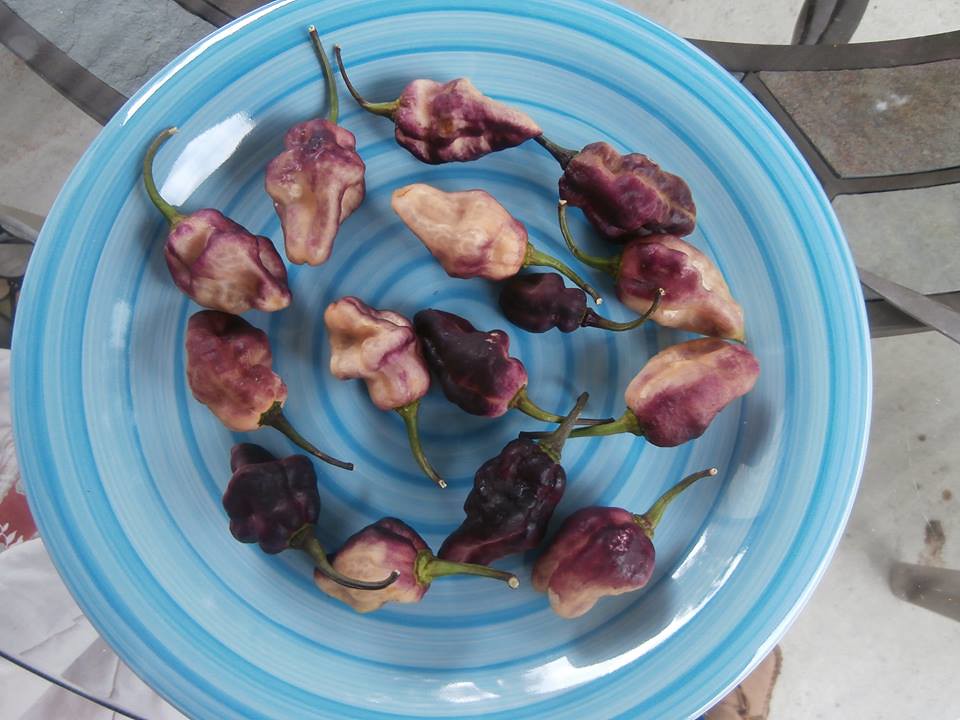
Only one seedling grew from this F2 parent of 7 pot Jonah x Pimenta da Neyde. Hoping to get the same color again. So I would also try to cross with that plant (assuming it makes it). I'd be happy to share F1 seeds if success with any of the crosses.

For the traits you are after, I would suggest a Capsicum baccatum with purple flowers. You would have the typical green speckling of the throat of your flower and the purple outer edge right off the bat to work with.Dulac said:Looking for a bridge hybrid to work with c.chinese to get baccatum-like flower also with annuum purpling of the flower. What does the flower look like? Also curious to what sort of flavor profile it would have with this interspecific species. I'm aiming for beauty, heat, and flavor for my hybrid. I'm also interested in growing out interspecific hybrids. Frutescens also has an interesting flavor that could turn up in the hybrids.
Take that cross baccatum and then use it both ways to your C. chinense.
My favorite C. frutescens is Cabai Burung Ungu with its pink flowers and it is the one you will see in some of my hybrids. If you want some C. baccatum genetics with purple flowers....
I can definitely hook that up for you, but I'd rather you work smarter than work harder and given your specific goals... I'd go with a simple C. baccatum with purple flowers. Perhaps even a C. praetermissum. You could find some useful genetics for your goals here... https://www.semillas.de/shop_en/

I'm not sure C. praetermissum would be fertile. I tried about 6 years ago with no luck. Adding wild genes sounds like a good idea. I'll have to do a germination test on my c. prat seeds to see if they are viable, since so many of my stock has gone bad.
edit: I think that Cabai Burung Ungu is possibly 3 species. It's certainly an interspecific hybrid. C. baccatum with purple flowers is probably a hybrid with c. annuum, but that would be my best bet. I'm not aware of any though. Unless you mean Cabai Burung Ungu, which most likely contains c.baccatum, c. annuum, and c. frutescens from my observations. I agree that would be a good pepper to cross with.
edit: I think that Cabai Burung Ungu is possibly 3 species. It's certainly an interspecific hybrid. C. baccatum with purple flowers is probably a hybrid with c. annuum, but that would be my best bet. I'm not aware of any though. Unless you mean Cabai Burung Ungu, which most likely contains c.baccatum, c. annuum, and c. frutescens from my observations. I agree that would be a good pepper to cross with.
I've had one hybridizer share a picture of a C. praetermissum interspecific C. chinense hybrid with me. I believe that it was genuine, but I also agree that sometimes it can take many tries and you may have no luck.Dulac said:I'm not sure C. praetermissum would be fertile. I tried about 6 years ago with no luck. Adding wild genes sounds like a good idea. I'll have to do a germination test on my c. prat seeds to see if they are viable, since so many of my stock has gone bad.
edit: I think that Cabai Burung Ungu is possibly 3 species. It's certainly an interspecific hybrid. C. baccatum with purple flowers is probably a hybrid with c. annuum, but that would be my best bet. I'm not aware of any though. Unless you mean Cabai Burung Ungu, which most likely contains c.baccatum, c. annuum, and c. frutescens from my observations. I agree that would be a good pepper to cross with.
Admittedly, if one looks at the research, it looks like C. praetermissum x C. baccatum or the reciprocal cross would be easier on paper.
Regarding C. frutescens 'Cabai Burung Ungu'... I can tell you I have made crosses with many different species both ways with this particular chili pepper. It is a most beautiful in my opinion and if you are interested in trying some crosses with its genetics in them... I can probably dig through my seeds and find you some.
I tried crossing C. chinense dominant 'Darth Maul' x C. frutescens 'Cabai Burung Ungu' and was not able to get seed, but I did get fruit set. As with many interspecific hybrids, I often find reduced seed set, reduced fruit size, and even no seeds at all but very small fruits.
I can assure you though, I have some very nice C. baccatum with purple flowers... that are not C. frutescens 'Cabai Burung Ungu'
Some informaton below for those still following this thread and interested in hybridizing.
This is a short write up to help others understand what is written inside a bit faster.
"Rules for understanding the genes are listed on page 1169 and 1177 of the article referenced.
The first letter of the symbol used should be the same as that for the gene name, which should describe a characteristic feature of the mutant type.
When the mutant is dominant, the first letter of the symbol is capitalized.
If the mutant is recessive, all letters of the gene symbol are in small letters.
Genes can’t be assigned symbols until supported by statistically valid data such as provided by producing filial generation 2 and BC or backcross populations.
Multiple alleles have the same symbol followed by a Roman letter or Arabic superscript, and mimics may either have distinctive names and symbols, or the same gene symbol followed by a hyphen and a unique Arabic numeral or Roman letter.
Of particular interest to me, some genes or mutant genes were found by interspecific hybridizing.
Two dwarf mutants/genes were produced or discovered by interspecific hybridizing. Hybrids between Capsicum baccatum. and C. annuum gave us dw-3.
The other mutant was discovered when interspecific hybrids were made between C. frutescens and C. annuum and resulted in dw-4.
More dwarf genes were created or incited by the interspecific hybrids between C. annuum and C. chinense.
The pi or v gene as it is sometimes referred to is responsible for green and white leaf variegation. Pi = plastid instability and v = variegated… so take your pick.
The bv gene aka mutant-2 gene is responsible for bushy variegated plants. The apical leaves are creamy white with small green areas. Affects lateral shoot development to produce a bushy plant.
Marbled leaves are created by m-1, m-2, m-3, and m-4 genes.
The m-1 gene, a marbled gene, results in the first true leaf developing isolated zones of white, light green, and normal green. The boundaries of the zones are distinct from one another. The leaves are puckered with irregular margins where marbling occurs.
The m-2 gene results in all leaves having zones of white, light-green and green when grown in the greenhouse. When grown in the field, only the first true leaf has the marbled pattern. At least one of the seeds I put in the pepper football has this gene. Gene found in chili pepper ‘Pasardjishka kapia 794’.
The m-3 gene is well pronounced in the greenhouse and in field grown specimens. Gene identified in chili pepper ‘Zlaten Medal’. The Albena chili pepper was further created by using gamma radiation on Zlaten Medal to induce further mutation. https://mvd.iaea.org/#!Variety/2189
The m-4 marbled gene has distinct zones of white on the green foliage and its young fruits. Identified by the presence of distinct zones of white on the foliage and young fruit.
Variegated mottled mutants are controlled by the vgm gene.
Variegated mottled plants have leaves that are mottled yellow to light green. Younger leaves will tend to be more intensely mottled to entirely yellow, particularly near the petiole.
The allelic series vg+ (nonvariegated) > vgm > vgv is the order of descending order of dominance. Meaning, vg+ nonvariegated gene is dominant to vgm and vgv is recessive to vgm.
Variegated virescent mutant is controlled by the vgv gene.
The seedlings first leaves are yellow(identify by yellow cotyledons) as they first emerge, but the cotyledons will rapidly develop green coloration. This is one reason to look at your seedlings every day as they emerge. True leaves will start out yellow as well as they begin to grow, but then turn nearly normal green at maturity.
Vgv is allelic recessive to Vgm.
The greenish yellow variegation is controlled by the chl gene. Cholorina aka chl is the greenish yellow variegation or chlorophyll deficiency gene.
The deformed and undulated green virescent variegated leaves are controlled by the gene dvg."
https://pdfs.semanticscholar.org/02cb/c24c92eb348b05319ed811ecbd68decc7fa3.pdf?fbclid=IwAR2tgTEvTGmRThKeInw65Xaj5bzEroKoX8-Dq72fDg4pPilcz-FSsDDkF4M
On the subject of Capsicum 'Pimenta De Neyde', have you considered a backcross? It might prove interesting at the f2 stage to do so from the little bit I've noticed on that particular plant, I suspect some of the genes of importance may be quantitative in nature.Dulac said:Looking for a bridge hybrid to work with c.chinese to get baccatum-like flower also with annuum purpling of the flower. What does the flower look like? Also curious to what sort of flavor profile it would have with this interspecific species. I'm aiming for beauty, heat, and flavor for my hybrid. I'm also interested in growing out interspecific hybrids. Frutescens also has an interesting flavor that could turn up in the hybrids.
Only one seedling grew from this F2 parent of 7 pot Jonah x Pimenta da Neyde. Hoping to get the same color again. So I would also try to cross with that plant (assuming it makes it). I'd be happy to share F1 seeds if success with any of the crosses.

And Congratulations on your fruit you have produced so far. It is exciting to see ones work progress and even more so when you can get something that is pleasing to the eye and to the palate so quickly.
If you would allow me to send you some seed, I think I may have some genetics that will fit your needs. Feel free to do with them as you will. While I always ask for seed, pictures, etc. to be returned, I also won't call you out for not doing so.
If you like variegated seed, I also recently pulled some C. annuum 'Scarlett's Chili' fruit from seed I acquired from Indonesia and some from The Hippy Seed Company... the one from Indonesia has an additional recessive trait of erect fruit.
I ended up ordering some Cabai Burung Ungu seeds, since I really want to use it in this cross. The reason I haven't backcrossed with pimenta da neyde is due to the bad production, low heat, and taste of the pepper. However, I may want to backcross to try to get the incredibly pale yellow it appears to have under the purple of its fruit if it doesn't show up again. I'm planning to order new pimenta da neyde seeds with yellow 7 pot bubblegum (the bleeding calyx is very interesting). I want to cross those two together to cross with the others. Scarlett's Chili looks like a good variegated pepper.
Productivity and heat are definitely quantitative traits which is a very good reason for not wanting to do a backcross. If the color might be worth it to you, I'd still give it a go with the understanding that of course... you might also be creating a lot of work for yourself as well to restore productivity and heat to the desired level you are after.Dulac said:I ended up ordering some Cabai Burung Ungu seeds, since I really want to use it in this cross. The reason I haven't backcrossed with pimenta da neyde is due to the bad production, low heat, and taste of the pepper. However, I may want to backcross to try to get the incredibly pale yellow it appears to have under the purple of its fruit if it doesn't show up again. I'm planning to order new pimenta da neyde seeds with yellow 7 pot bubblegum (the bleeding calyx is very interesting). I want to cross those two together to cross with the others. Scarlett's Chili looks like a good variegated pepper.
I'm a big fan of the bleeding calyx genetics as well, but I'm working with the Morangum for that trait as I also like the clustering fruit which is another quantitative trait.
Definitely a good choice on ordering those C. frutescens 'Cabai Burung Ungu' if you like that flower even half as much as I do. The colors in the fruit itself and the juiciness of the fruit are also something I truly love. Although, I wish the fruit was a bit bigger.
Candy Coat, if your looking for an interspecific variegated cross, is just a little over 50% annuum with C. chinense and C. frutescens genes. I've got some seed germinating right now from Drax Diego and I can tell you it is showing variegation in the cotyledons. https://www.draxpeppers.com/product-page/candy-coat-f3-o-p
It sure will be interesting to see what happens if it crosses with the much larger (7 pot Jonah x pimenta da Neyde) x Trinidad Scorpion Moruga. These ripen to red with purple and have good flavor and superhot heat. I think we like similar traits. I also look for clustering. Maybe I can improve the pimenta da Neyde's production with backcrossing, which would make it a better plant for transferring the dark purple fruit and foliage. Jonahs and Morugas are powerhouses. It might also be a good idea to try a pimenta da neyde cross with Cabai Burung Ungu.
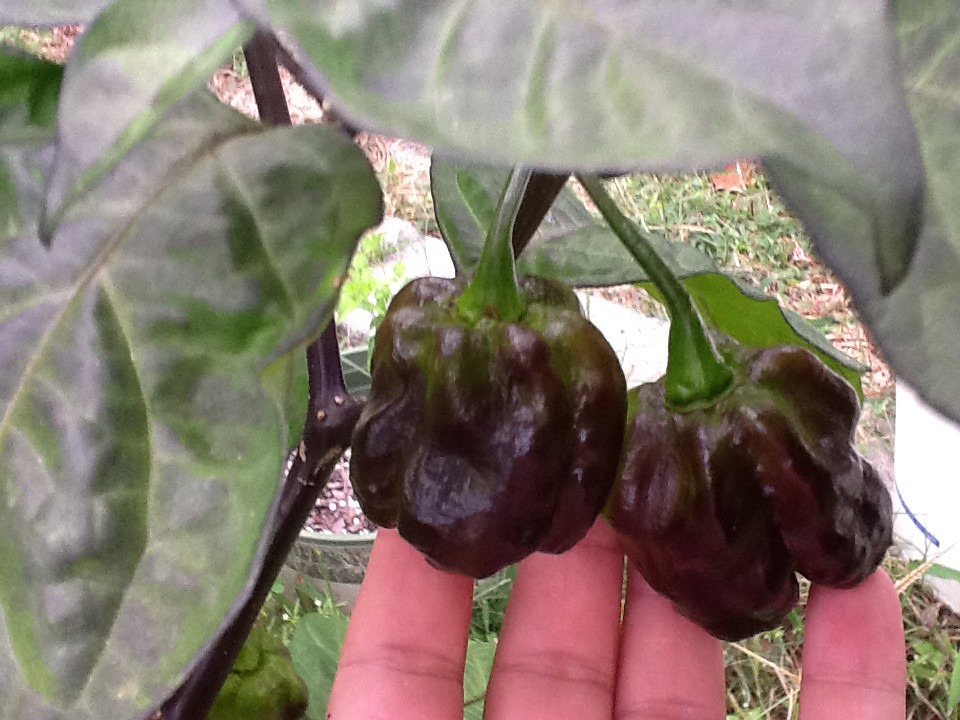

Okay, free seed has been sent out today.
If you don't get your free f1, f2, f1bc1 type crosses in the next week or two for those that are stateside let me know and I dig into my stores or see what is popping today.
I try to toss in a few extras. Please be warned, if you don't get variegation in an f1 cross that is a good thing. Even in an f2 you may not see variegation if you are not growing up a large enough number of seedlings.
Have fun with these my friends.
https://youtu.be/lYeySym4g7g
If you don't get your free f1, f2, f1bc1 type crosses in the next week or two for those that are stateside let me know and I dig into my stores or see what is popping today.
I try to toss in a few extras. Please be warned, if you don't get variegation in an f1 cross that is a good thing. Even in an f2 you may not see variegation if you are not growing up a large enough number of seedlings.
Have fun with these my friends.
https://youtu.be/lYeySym4g7g
Seeds received. Will try to get them going by Monday. I have numbered each to track progress. So, in my famous last words: We will see how it goes.

skullbiker said:Seeds received. Will try to get them going by Monday. I have numbered each to track progress. So, in my famous last words: We will see how it goes.
E2D86550-AD08-4C18-9F68-445C4E5A5D2E.jpeg
I think you guys have figured out, I make a lot of crosses and many of them over and over and over again. That is why I try to remember to assign a new number to the same cross when I make them. I keep my fruits separated just in case there is a mix up or there is a deviation from one parent to another. As I have multiple VSRP plants for example.
I'm probably more excited to see you growing out some of these than you are. Nervous as well, as I know full well how even an unintentional mistake such as not noticing pollen forming on an anther on an immature flower can screw with ones results.ADRUNKK said:@PollenNut I received my seeds too. Thank you very much, I'm super excited about this grow season. I will start my seedlings today. I will keep you updated with pics, and will send you the isolated pods as requested of the ones i get to germinate.
20200208_113704.jpg
This is why I make the crosses like I do frequently.... you will notice I use variegated moms x something else so I can see that there is no variegation in the progeny and that works so long as the pollen donor is not variegated. You should get 100% nonvariegated in your f1 when that is the case. If the pollen donor is also variegated... that is where you have to look for other tell tale signs in your f1 to prove it out.
I am constantly sharing next generations stuff for free though my friends. You need only ask yourself... is it worth the risk of growing out the mother plant to warrant growing out something totally new if this pollen nut is actually successful. Everything is always a gamble.... I'm glad you gambling on me, but I want to see some gambling on yourself in the future. That is my real aim in sharing many of my hybrids.
These seeds for instance were all f1, f2, f1bc1 seeds I sent out today. Some will be going to members of this group... others to other groups. I've frequently got stuff going out so if you have some goal in mind... contact me and I'll see if I have something that can help you towards your goals.
https://youtu.be/lYeySym4g7g
@PollenNut Well I'm very stupid when it comes to this crossing stuff. It was something I wanted to get into but after seeing your posts I have given up in it until I can put my nose in some books and figure out what the hell it is you talking about. I'm so -un-knowledgeable at this crossing stuff that I don't even know what f1, f2, f1bc1 even means, but one day I will figure it out. In the mean time I am excited to see your work grow and learn more through your posts and growing your special crosses.
F1= first filial generation... literally the first seeds from any cross you are growing out. F2 - second filial generation or the second generation your growing out.ADRUNKK said:@PollenNut Well I'm very stupid when it comes to this crossing stuff. It was something I wanted to get into but after seeing your posts I have given up in it until I can put my nose in some books and figure out what the hell it is you talking about. I'm so -un-knowledgeable at this crossing stuff that I don't even know what f1, f2, f1bc1 even means, but one day I will figure it out. In the mean time I am excited to see your work grow and learn more through your posts and growing your special crosses.
F1 grows are typically very small where f2 grows are much larger as you are going to see a lot more variation in the f2.
F1BC1 = first filial generation backcrossed to one of the parents.... so you always get a double helping of one of the parents in a BC cross or backcross.
When in doubt, just put pretty to petty and label your stuff.
@PollenNut
I got everything you sent started on Saturday. Let's hope they germ.
Of the (3) f1bc1's you sent in bag 6, 1 seed appeared to be cut down the center and the other 2 seemed to be missing half of the casing. I still planted them and we'll see what happens. This was bag 6 in the picture on post 34.
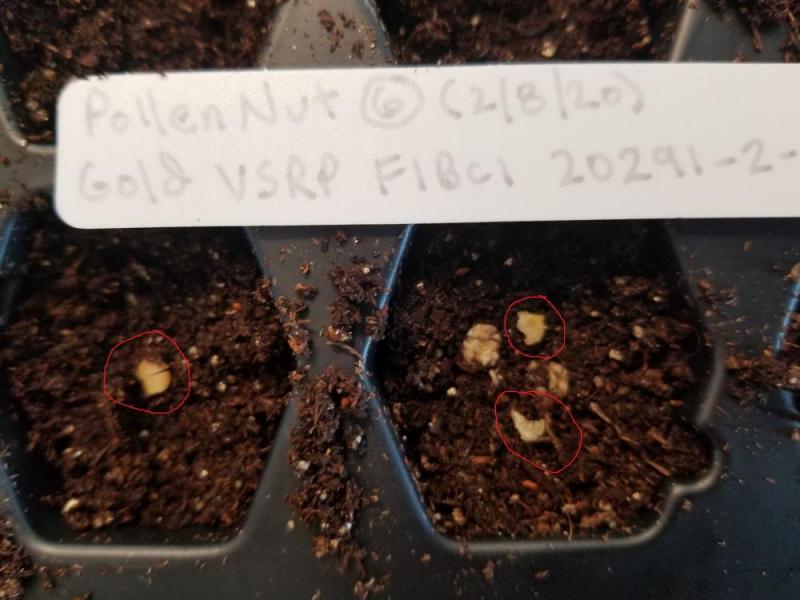
All others looked perfectly fine.
I got everything you sent started on Saturday. Let's hope they germ.
Of the (3) f1bc1's you sent in bag 6, 1 seed appeared to be cut down the center and the other 2 seemed to be missing half of the casing. I still planted them and we'll see what happens. This was bag 6 in the picture on post 34.

All others looked perfectly fine.
Attachments
Out of 70 seeds i started 15 of them are yours. Im super stoked to see what turns out. Now I need to hurry up and finish up my grow cabinet before these start to sprout.
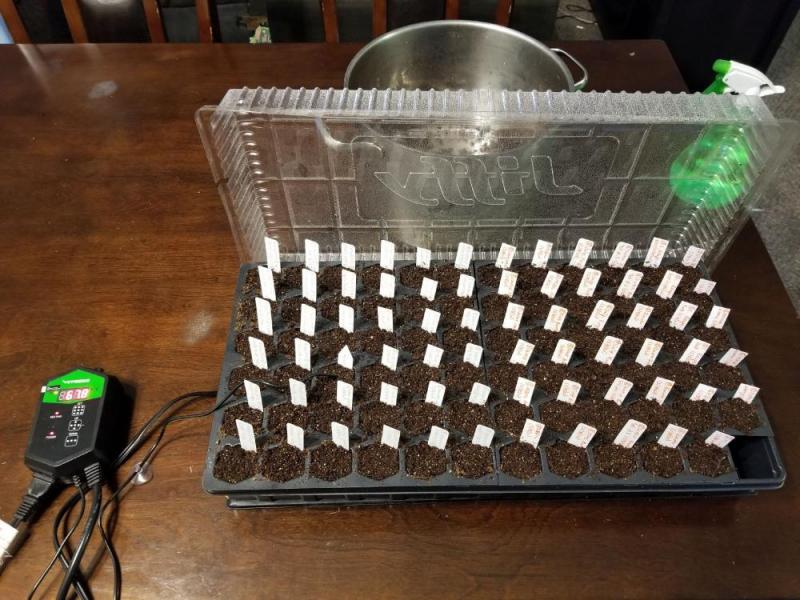
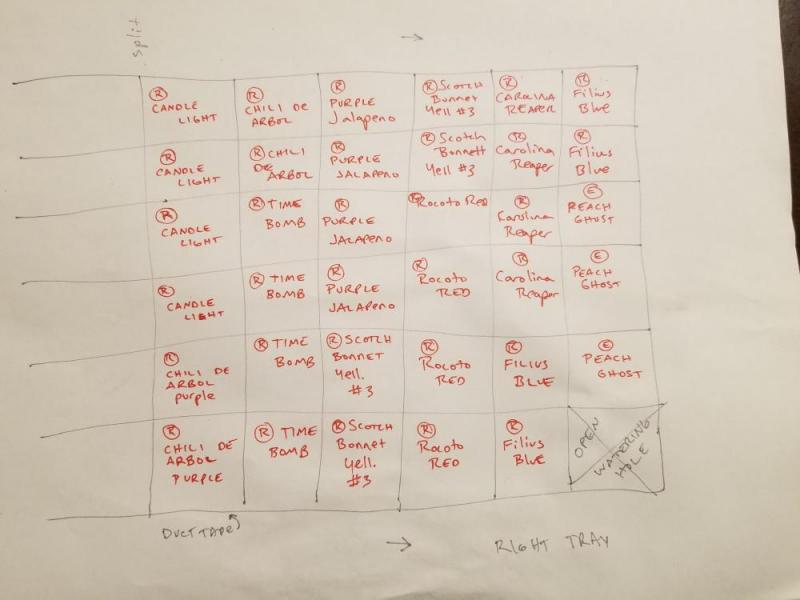
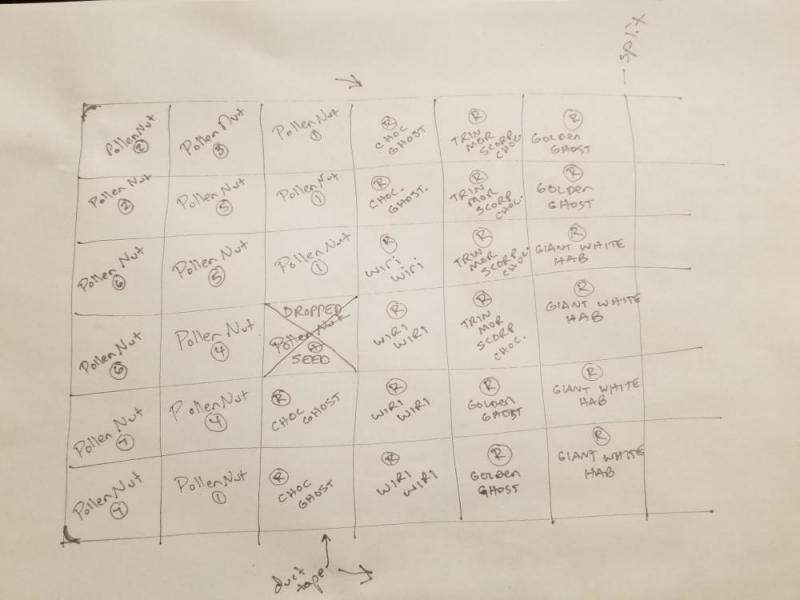



Attachments
Pepper-Guru
eXtreme
ADRUNKK said:Out of 70 seeds i started 15 of them are yours. Im super stoked to see what turns out. Now I need to hurry up and finish up my grow cabinet before these start to sprout.



Nice! Glad to see folks trying out your work PollenNut! Early adopters of some really really cool stuff!




